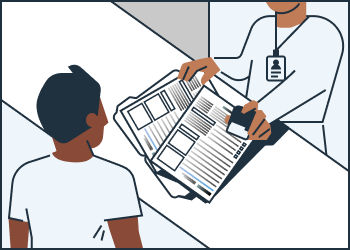Order a witness to appear at a deposition
If there is a witness you need to attend a deposition, you may use a subpoena to order that person to come to the deposition.
Before you start
What is a deposition?
A deposition is taking a witness' testimony outside of court. At a deposition, the witness is sworn in, and answers questions under penalty of perjury. A court reporter is hired to transcribe the testimony. The witness might also be audio or video recorded. A deposition is useful to know in advance what a witness will say at trial, and creates evidence that can be used if the witness changes their story at trial, or ends up not being able to go to the trial.
You may have to pay witnesses
Witnesses can ask for $35 a day and $.20 per mile each way. If they request to be paid before the deposition, you must pay them. Otherwise they are not required to appear.
Be prepared to pay the witness when they come to the deposition regardless of whether they've asked to be paid.
How to use a subpoena
-
Take a blank subpoena to court

Take a blank Deposition Subpoena for Personal Appearance (form SUBP-015) to your court clerk's office.
The clerk will issue the subpoena. This means the clerk signs and stamps the subpoena before you fill it out.
Bring a separate one for each person, business, or agency you want to subpoena.
A few courts post issued subpoenas online. The subpoena will have a clerks' signature and stamp on them. Check on their website or call and ask if they have them available online. -
Fill out your subpoena

Complete the case information in the caption and write the name, address and phone number of the witness you want ordered to appear.
In section 1, complete the information about your trial or hearing date.
Use the check boxes to indicate if you are:
- Deposing a corporation, LLC, or other business entity and need it to designate someone to testify
- Having a stenographer record the deposition
- Making an audio or video recording the deposition
- Taking the deposition of an expert witness or physician and want to be able to play the deposition as evidence at trial
If you're deposing a corporation, LLC, or other business entity, check box 2, and fill in a description of the matters you wish the witness to testify about.
This is important so that the entity can send a person to the deposition with knowledge of the things the deposition will be about.
The date, name, and signature will have already have been completed by the court.
The location of the deposition should comfortably fit all the attorneys or self-represented parties in the case, the witness, and a stenographer.
Business centers, libraries, and other facilities often have conference rooms that can be rented by the hour. Schedule the location of your deposition before you complete the subpoena.
The location of the deposition must be within 75 miles of the witness's residence, or 150 miles if it is being held in the same county as the court the case is filed. -
Make copies
Make at least 3 copies of your Subpoena form. One for you, one for the other attorney or self-represented party, and another for the person you need to subpoena.
Keep the original and bring it with you to court.
-
Deliver the subpoena

Hand deliver ("serve") a copy (not the original) of the Subpoena form to the person or business you are subpoenaing, or their attorney.
You can also serve by mail, but only if the other side has already filed papers with the court. In addition to the witness, you must also serve any other attorney or self-represented party in your case, although they typically can be served by mail.
Corporations and LLCs typically have a designated person or law firm that you need to serve (agent for service of process). They should be listed with the California Secretary of State.
Corporations or LLCs can request a different type of service for subpoenas, such as faxing the subpoena. -
Fill out the Proof of Service forms

Fill out page 2 of the original Subpoena form.
Then have the person who delivered the subpoena sign at the bottom-left of page 2. Ignore the signature line on the right-hand side- it is only used if a sheriff or marshal serve the subpoena.
Fill out another Proof of Service for each other attorney or self-represented party. Use form Proof of Service by First Class Mail (form POS-030) for mail service or Proof of Personal Service (form POS-020) for personal service.
-
Bring the subpoena to the deposition
Bring the original Subpoena form to your deposition.
If your witness does not appear, and you cannot informally resolve it, you will present the Subpoena to the court as part of a motion. In the motion you will ask that the witness be ordered to appear and pay the cost of the missed deposition. Your local law library or self-help center may be able to assist you with a template and instructions for this motion.
Once you've completed and served the subpoena, you can expect the witness to appear at the deposition.

